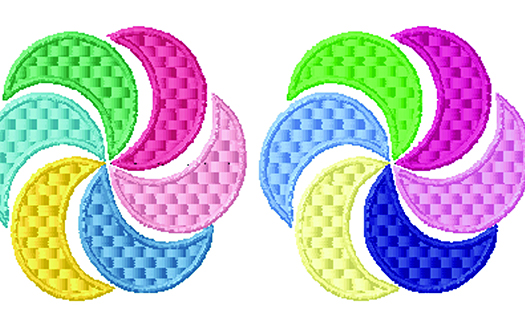
Digitizing complex embroidery designs may appear daunting, particularly for beginners. However, with careful guidance and practical insights, mastering the art of digitization becomes achievable. In this comprehensive guide, we’ll delve deeper into the intricacies of digitizing complex embroidery designs, offering step-by-step tips and tricks for success.
Understanding Embroidery Digitization
Embroidery digitization is the transformative process of converting intricate artwork or designs into a language that embroidery machines can comprehend. This intricate process involves translating the visual elements of a design into a series of stitches and commands that the embroidery machine executes. Complex embroidery designs often feature intricate patterns, delicate details, and a multitude of colors, making the digitization process both challenging and rewarding.
1. Choose the Right Software
Selecting the appropriate software is paramount to the digitization process. A plethora of embroidery digitizing software options are available, catering to varying skill levels and requirements. Beginners may find user-friendly software such as Wilcom EmbroideryStudio or Hatch Embroidery particularly helpful, while seasoned professionals may opt for more advanced solutions like Embrilliance. When choosing software, consider factors such as ease of use, available features, stitch simulation capabilities, and automatic color matching functionalities.
2. Start with Clear Reference Images
Clear and high-resolution reference images serve as the foundation for successful embroidery digitization. Whether it’s a digital illustration, a scanned drawing, or a photograph of an existing embroidery sample, quality reference images are essential for accurately replicating the intricacies of the original design. Ensure that your reference images capture all the necessary details, textures, and color nuances to guide your digitization process effectively.
3. Break Down the Design into Elements
Complex embroidery designs often comprise multiple elements, including shapes, lines, text, and intricate motifs. Breaking down the design into these individual elements facilitates a systematic approach to digitization. Start by identifying the primary components of the design and focus on digitizing them one at a time. This methodical approach enables you to allocate sufficient attention to each element, ensuring meticulous attention to detail throughout the digitization process.
4. Utilize Vector Graphics for Precision
Vector graphics offer unparalleled precision and control, making them indispensable for digitizing complex embroidery designs. Leveraging vector drawing tools such as those found in Adobe Illustrator or CorelDRAW allows you to create clean, smooth outlines of design elements with ease. Vector-based artwork ensures crisp lines, smooth curves, and precise shapes, laying the groundwork for flawless embroidery digitization.
5. Simplify Complex Details
Simplification is key when digitizing complex embroidery designs. While intricate details may enhance the visual appeal of a design, they can pose challenges during the digitization process. Focus on capturing the essence of the design while simplifying complex details to ensure optimal embroidery quality. This may involve reducing the number of colors, eliminating fine lines, or amalgamating small details into larger shapes for improved clarity and readability.
6. Experiment with Stitch Types and Directions
Embroidery machines offer a myriad of stitch types and directions, each contributing to the overall texture and appearance of the design. Experimenting with different stitch types, such as satin stitches, fill stitches, and running stitches, allows you to achieve diverse visual effects and surface textures. Consider the characteristics of each stitch type and its suitability for specific design elements to create captivating embroidery designs that stand out.
7. Test and Adjust Settings
Before finalizing a digitized embroidery design, it’s essential to conduct thorough testing to ensure optimal stitch quality and appearance. Stitch out a sample of the design on scrap fabric using your embroidery machine and meticulously evaluate the results. Pay close attention to details such as stitch density, thread tension, and color accuracy, making any necessary adjustments to the design settings to achieve desired outcomes.
8. Seek Feedback and Practice Regularly
Embroidery digitization is a skill honed through practice and experience. Don’t hesitate to seek feedback from experienced embroiderers or digitizers to refine your skills further. Engage with online communities, forums, and social media groups dedicated to embroidery digitization, where you can share your work, seek advice, and learn from others’ experiences. Regular practice is key to mastering the art of digitizing complex embroidery designs, so dedicate time to refine your skills and explore new techniques.
9. Consider Fabric Characteristics
When digitizing complex embroidery designs, it’s crucial to consider the characteristics of the fabric on which the design will be embroidered. Different fabrics have varying textures, densities, and stretch properties, which can affect how the embroidery design appears once stitched. Take into account factors such as fabric weight, weave type, and stretchiness when adjusting design settings such as stitch density, underlay stitching, and thread tension.
10. Pay Attention to Thread Color Changes
Complex embroidery designs often feature multiple colors, requiring frequent thread changes during the stitching process. To minimize interruptions and streamline production, strategically plan the sequence of color changes within the design. Group together areas of the design that use the same thread color or require similar thread types to minimize the number of thread changes needed.
11. Optimize Stitch Placement for Durability
Embroidery digitization isn’t just about creating visually striking designs—it’s also about ensuring durability and longevity. When digitizing complex embroidery designs, pay careful attention to stitch placement to enhance the design’s structural integrity. Avoid placing dense stitches or intricate details in high-stress areas of the design, such as corners or areas subject to frequent movement or friction. Instead, reinforce these areas with appropriate stitch types, densities, or underlay stitching to prevent puckering, distortion, or thread breakage over time.
Conclusion
Digitizing complex embroidery designs is a nuanced process that requires patience, precision, and creativity. By choosing the right software, starting with clear reference images, breaking down the design into manageable elements, and simplifying complex details, you can navigate the digitization process with confidence. Experimenting with stitch types and directions, conducting thorough testing, and seeking feedback from peers will further enhance your digitization skills over time. With dedication and perseverance, you’ll soon be proficient in embroidery digitizing complex designs, transforming your creative visions into stunning embroidered masterpieces.
FAQs (Frequently Asked Questions)
Q1: What is embroidery digitization?
Embroidery digitization is the process of converting artwork or designs into a format that embroidery machines can understand, enabling them to recreate the design with stitches on fabric.
Q2: Why is simplification important in digitizing complex embroidery designs?
Simplification is important in digitizing complex embroidery designs to ensure clarity, readability, and optimal stitch quality. By simplifying intricate details, the design becomes more embroidery-friendly and easier to replicate with stitches.
Q3: How can fabric characteristics influence the digitization process?
Fabric characteristics such as weight, weave type, and stretchiness can affect how embroidery designs appear once stitched. Considering these factors allows digitizers to adjust settings such as stitch density and thread tension to optimize embroidery results for specific fabrics.




